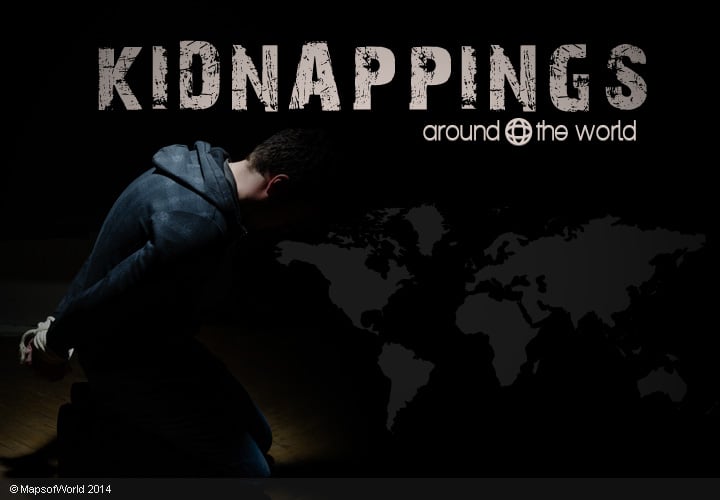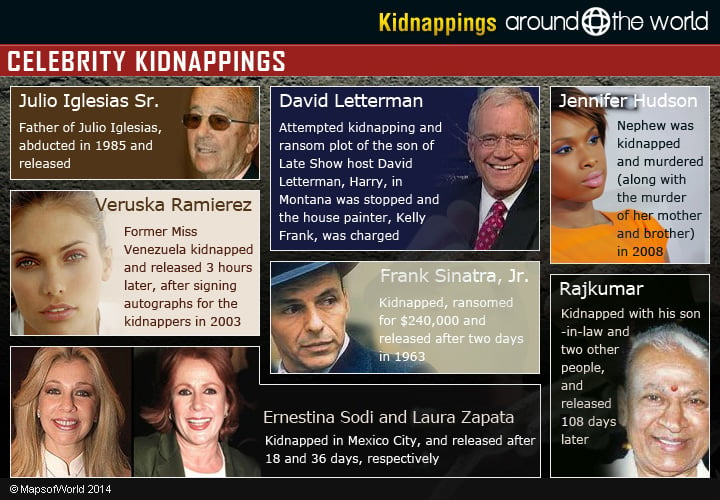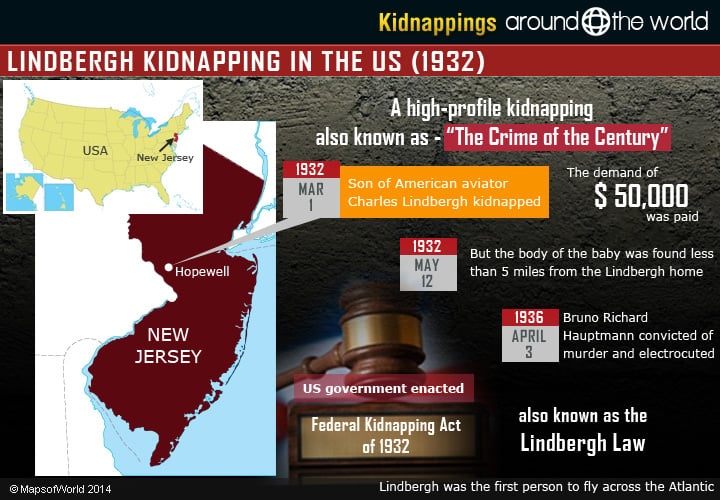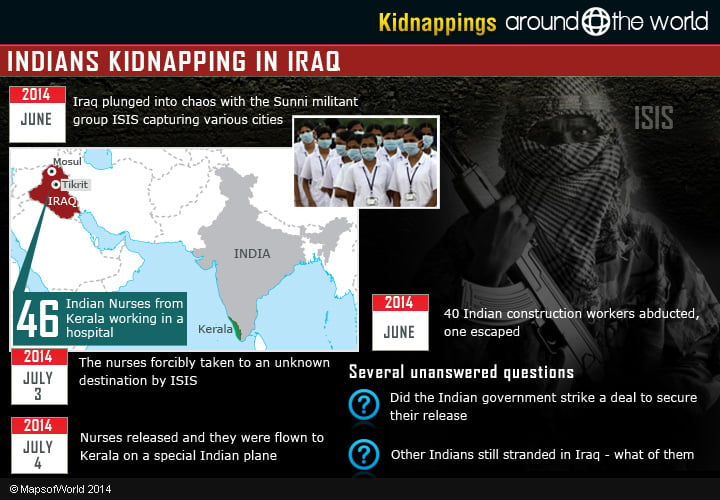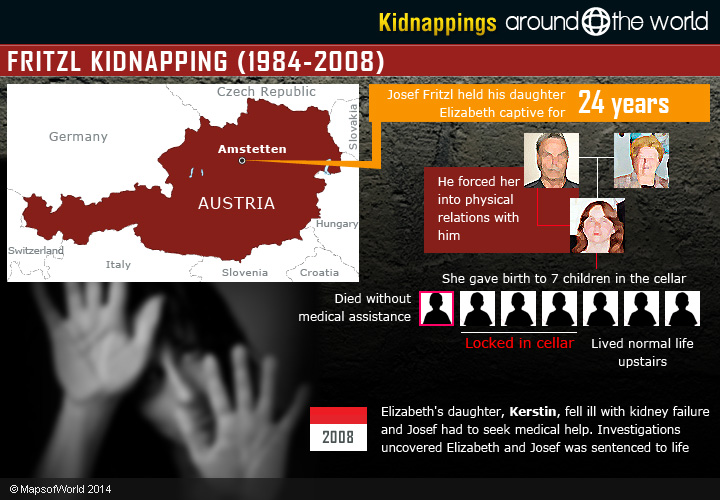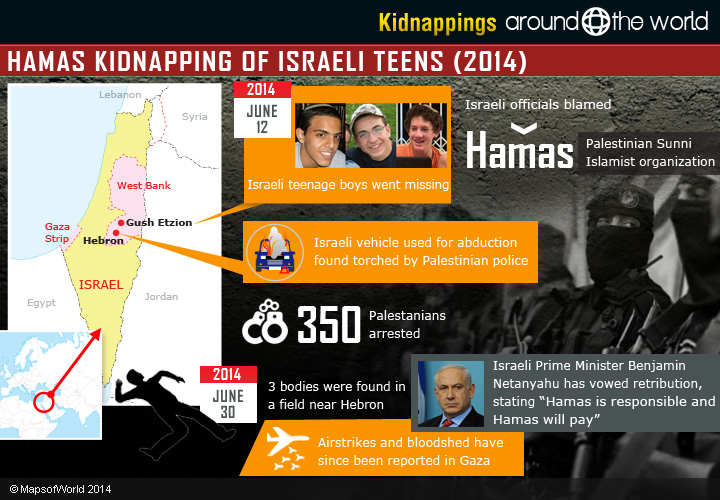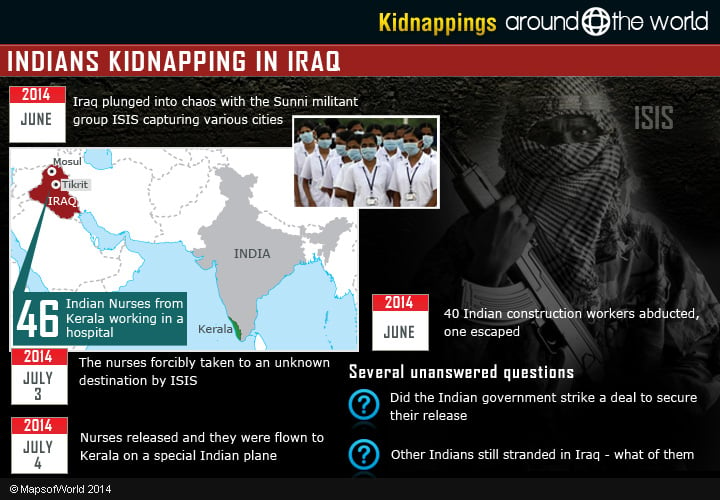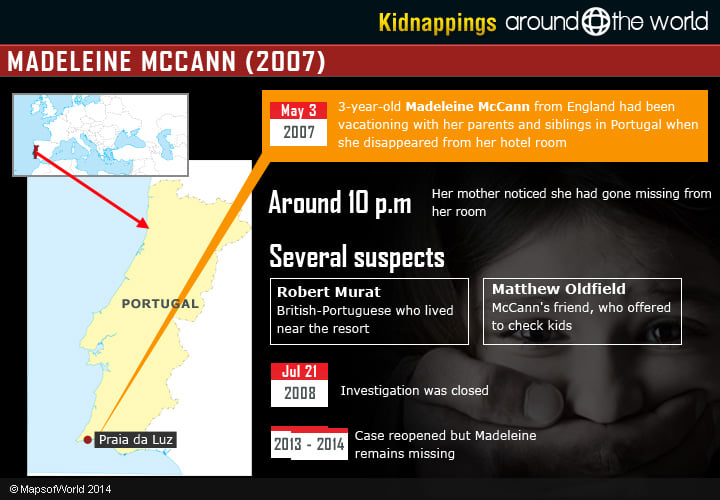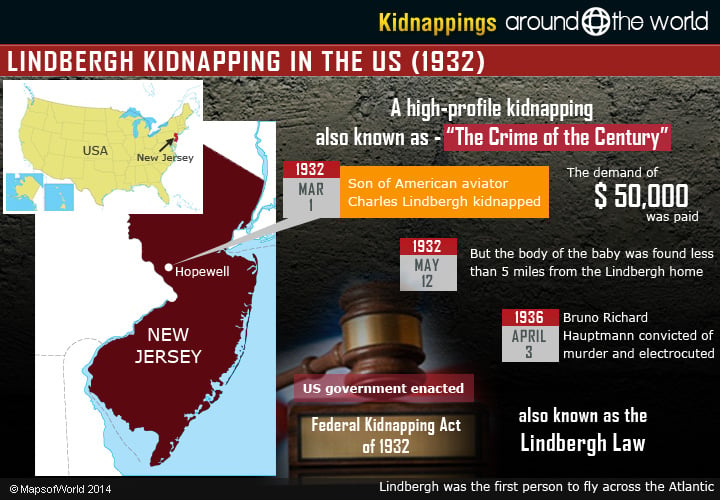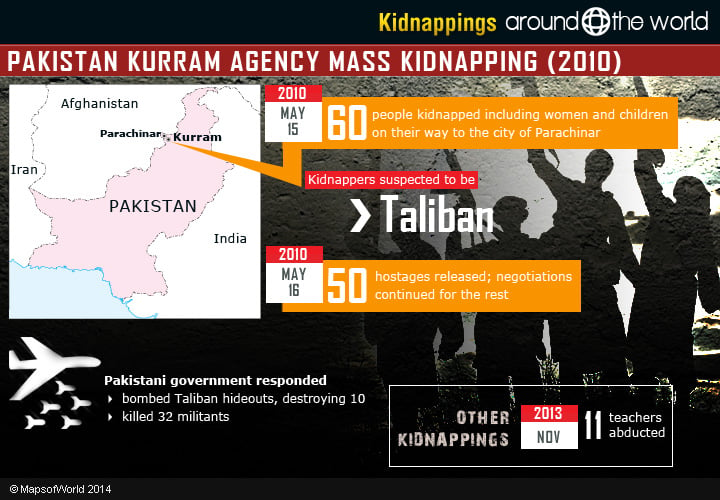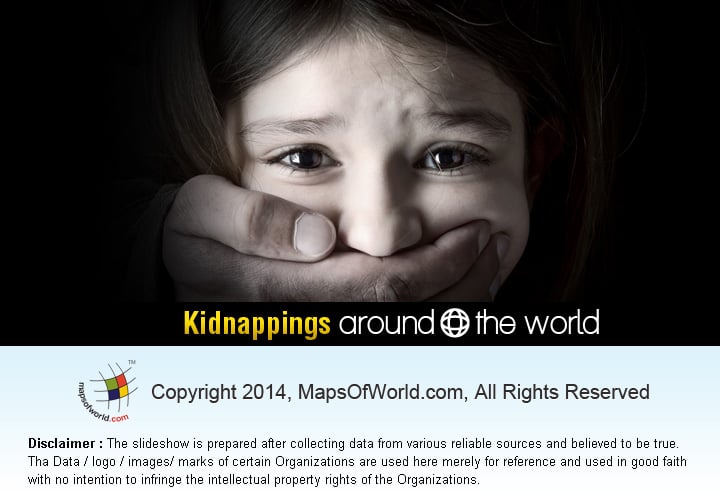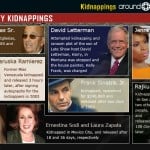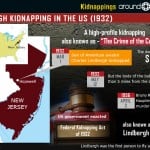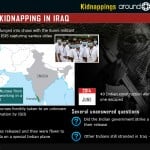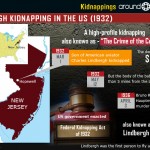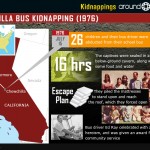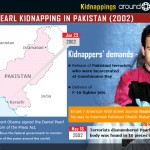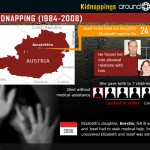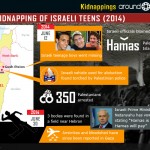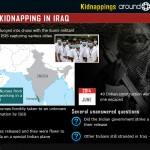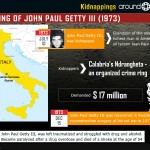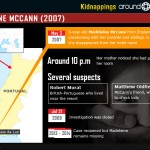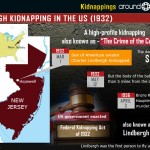Kidnappings Around the World
Untold numbers of children and adults are abducted every year. Though laws have been passed in many countries to allow government intervention, such as the law preventing transporting minors across state lines in the US, as well as police and media efforts to publicize the missing persons, kidnappings still occur at unsettling rates. In some countries with fewer laws and resources in place, many abductions go unreported. The media is a major influence in publicizing the kidnapping and helping in recovery efforts for the victim and finding the suspected kidnapper as well.
One tool is the missing person protocol, an alert system known as an AMBER alert in the United States or the Hannibal alert in Israel, and by other names around the world. These alerts are a way to quickly spread the news that the public should be on the lookout for a missing child, in the hopes of quickly recovering the child and stopping the abductor. These alerts often include descriptions of a vehicle being used in the abduction, its license plate number, and information on the suspect as well as the child.
Motives for kidnappings are quite varied, from political reasons to sexual and violent criminality, obsessive stalkers, and abusive family members. The victims are sometimes celebrities and the ultra-wealthy, or their children, who are held hostage in exchange for ransom, but more often, the victims are everyday people. Though strangers are sometimes responsible for kidnapping, many times someone close to the victim is responsible. In many cases, a custody dispute is at the heart of the issue, with parents each fighting for their children.
The outcomes of these kidnappings range from rescue to escape, release, long-term captivity, and often murder. In some cases, the truth remains unanswered, possibly forever.
Celebrity Kidnappings:
Julio Iglesias – The father of Julio Iglesias was abducted in 1985 and released.
David Letterman – The attempted kidnapping and ransom plot of the son of Late Show host David Letterman, Harry, in Montana was stopped and the house painter, Kelly Frank, was charged.
Jennifer Hudson -The American Idol contestant’s nephew was kidnapped and murdered (along with the murder of her mother and brother) in 2008.
Veruska Ramierez – The former Miss Venezuela was kidnapped and released 3 hours later, after signing autographs for the kidnappers in 2003.
Frank Sinatra – Frank Sinatra, Jr. was kidnapped, ransomed for $240,000 and released after two days in 1963.
Thalia – In 2002, the Mexican star’s sisters, Ernestina Sodi and Laura Zapata were kidnapped in Mexico City, and released after 18 and 36 days, respectively.
Rajkumar – In 2000, Indian actor and singer Rajkumar was kidnapped with his son-in-law and two other people, and released 108 days later.
Boko Haram Mass Kidnappings in Nigeria (2014)
On the night of April 14 and 15, 2014, about 276 girls were kidnapped from the Government Secondary School in Chibok, Borno, Nigeria during exams. The abduction has been claimed by Boko Haram (also known as the Congregation of the People of Tradition for Proselytism and Jihad), a terrorist group that has become pervasive in Northern Nigeria in a movement that is being called “the crisis.” The group of Islamist extremists has attacked Christians, as well as many Muslims and schools, believing that girls should not be educated. Additional kidnappings have continued to occur, including 91 more on June 24, as well as hundreds of murders. Some girls have been recovered, though they were left raped and beaten. Some others were found dead.
Since around 2009, Boko Haram have been responsible from between up to 12,000 deaths and 8,000 injuries (according to President Goodluck Jonathan, though estimates vary). About 4,000 of those deaths occurred this year (2014).
The al Qaeda-trained militants have continued to hold the children hostage, using them as a shield to prevent the Nigerian Army from attacking Boko Haram. The kidnapping is also being used as a way to instigate political unrest and protests against the government, so that Boko Haram can achieve power. The terrorists have said they will sell the girls, and the group is known to use many of the kidnapped children as soldiers. The children are being converted to Islam, and the girls have been trafficked to nearby countries to become brides.
A major social media movement arose around the world after protests in Los Angeles and London on May 3 and 4, and got the hashtag #BringBackOurGirls trending on Twitter around the world with help from celebrities and politician helping to spread awareness, including First Lady of the United States, Michelle Obama. The result has been action from the UK, US, France, China, Canada, Iran, and Israel, who have all offered resources and assistance in the effort to rescue the girls.
In early July, 63 hostages escaped from the terrorists during a battle between Boko Haram and the Nigerian Military.
Hamas Kidnapping of Israeli Teens (2014)
Three teenage boys, Naftali Frankel (16 years old,) Gilad Shaer (16), and Eyal Yifrah (19) went missing on June 12, 2014 from Gush Etzion. The boys were seen hitchhiking home from school in the West Bank around 10 pm, and at 10:25 pm, the local emergency hotline received a call from one of the boys reporting the kidnapping. They were unable to reconnect with the victim, however, and hours later the families began to report their absence to the police. The kidnapping alert (called a Hannibal alert) was issued the following day at 11 am. The same night, a Hyundai i35 with Israeli plates was found torched near Hebron by Palestinian police, and was likely the vehicle used in the abduction. A search and rescue team of over 2,500 searched the nearby villages in what became known as “Operation Shuvu Achim” (Bring Back Our Brothers, or Brother’s Keeper).
Israeli officials have blamed Hamas, the Palestinian Sunni Islamist organization, known as the Islamic Resistance Movement, for the kidnappings. Several countries and political organizations, including the European Union, United States, Japan, Egypt, and Jordan consider Hamas to be a terrorist organization, though other countries including Russia and China, as well as several Arab countries to not agree. Hamas have not yet claimed responsibility for the kidnapping. However, the conflict between Israel and the Hamas has led to the arrest of about 350 Palestinians since the kidnapping, though the Palestinian President Mahmoud Abbas has criticized the kidnapping and has cooperated in the recovery efforts. Just months ago, Israel and Palestine had been working on peace negotiations.
Two suspects who have previous arrests and convictions related to terrorism have been identified: Marwan Kawasmeh (29 years old) and Amar Abu-Isa (32), both associated with Hamas. The two men have not been seen since the boys were abducted.
On June 30, three bodies were found in a field near Hebron. Israeli Prime Minister Benjamin Netanyahu has vowed retribution, stating “Hamas is responsible and Hamas will pay,” and that the boys “were kidnapped and murdered in cold blood by wild beasts.” Airstrikes and bloodshed have since been reported in Gaza.
Indians kidnapping in Iraq (2014)
As Iraq plunged into chaos in June, with the Sunni militant group ISIS capturing various cities including Mosul and Tikrit, there was concern in India about the several thousand Indian nationals working in Iraq. Tikrit fell into the militants’ hands on June 11. The concern of the Indian and Kerala governments and nurses’ relatives intensified after horror stories of atrocities committed by Isis came to light.
When Isis took control of Tikrit, there were 46 Indian nurses — almost all of them from the state of Kerala — working in a hospital there. In the initial weeks, there seemed to be no direct threat to their lives, but when the security situation deteriorated and Iraqi government troops tried to re-take Tikrit, masked gunmen, presumably Isis militants, asked the nurses to shift to the hospital basement.
On July 3, Indians were shocked to hear that the 46 nurses had been forcibly taken to an unknown destination by ISIS, which had also abducted around 40 Indian construction workers in June.
But the fluid situation changed rapidly, and on July 4, news started trickling in that the nurses had been released and safely handed over at the neutral venue of Erbil. From there, they were flown to Kerala on a special Indian plane.
Several unanswered questions remained including whether the Indian government struck a deal to secure their release. However, with other Indians still stranded in Iraq, the Indian government has its task cut out in this ongoing crisis.
Pakistan Kurram Agency Mass Kidnapping (2010)
On May 15, 2010, 60 people were kidnapped from the Kurram Tribunal Agency in Pakistan, including women and children. The kidnappers were suspected to be Taliban militants who were dressed as police officers, as the region has been overrun by the Islamic militants. The women and children were abducted as they traveled in vehicles on their way to the city of Parachinar. The Taliban did not take responsibility for the kidnapping, but they have been active in the region previously, and abductions for ransom have occurred frequently.
On May 16, 50 of the hostages were released, as negotiations continued for the remaining 10, who were government employees. The Pakistani government responded by bombing Taliban hideouts, destroying 10 of them and killing 32 militants. The region has faced continued Taliban attacks and kidnappings, including the abduction of 11 teachers in November 2013.
Madeleine McCann (2007)
In one of the most infamous missing children cases in recent history, three-year-old Madeleine McCann of Leicestershire, England had been vacationing with her parents and and younger siblings in Praia da Luz, Portugal when she disappeared from her hotel room. Madeleine’s parents, Kate and Gerry McCann, were dining with friends at a tapas restaurant in their resort on May 3, 2007, while their children slept in their room. The couple and their friends periodically checked on the children throughout the night, but at around 10 p.m. Kate noticed Madeleine had gone missing from her room. The search for the missing child began quickly after that, with the police, resort staff, and other guests assisting in the search. The Portuguese police worked to find Madeleine in the weeks and months that followed, but botched their investigations, including not securing the crime scene or collecting the evidence and conducting tests right away, making finding out the truth much more difficult. The British National Policing Agency and the Control Risks private security company also became involved.
What followed was a media circus and many theories, but few answers. Even today, accusations and theories abound – with fingers pointing to the parents, who either left their children unsupervised in a hotel room or, as some suspect, worse (one theory is that Madeleine died in an accident and her parents staged the kidnapping to cover up their mistakes and perhaps sedating the child with medication that killed her), or to a random kidnapping by one of many men seen in the area. Since no trace of Madeleine has been found, some suspect that she was transported out of Portugal and perhaps sold into slavery.
There have been several suspects in the case. First was Robert Murat, who was British-Portuguese and lived near the resort. He had showed interest in the case and offered his services as an interpreter for the police, raising suspicions, but he was soon cleared of any involvement. The friend of the McCann’s, Matthew Oldfield, who had offered to check on the McCann kids as he checked on his own just before Madeleine went missing, was also suspected and cleared. The parents of Madeleine McCann have been considered suspects as well, but the investigation was closed on July 21, 2008, without any charges filed. The case was re-opened in 2013 and 2014, with investigations into burglaries in the area that may have been linked to Madeleine’s disappearance. Madeleine remains missing, and the details of the night she disappeared are still unknown.
Daniel Pearl kidnapping in Pakistan (2002)
Israeli / American journalist Daniel Pearl was abducted in Karachi, Pakistan around 7 pm on January 23, 2002. Pearl had been living and working in Islamabad, Pakistan as the South Asia bureau chief for the Wall Street Journal, and was on his way to interview Pakistani Sheikh Mubarak Ali Shah Gilani at the time of his kidnapping. Pearl had been investigating the “Shoe Bomber,” Richard Reid (who had attempted to detonate bombs in his shoes on a flight from Paris to Miami in 2001) and his potential involvement with al Qaeda.
Instead of meeting with Gilani, Pearl was taken hostage by Pakistani militants, who claimed that he was a CIA spy. The group, led by Omar Sheik, sent ransom notes and photos of Pearl holding a daily newspaper to prove he was still alive, emailing them to US officials, using the e-mail address [email protected]. For ransom, the kidnappers demanded that the US release the Pakistani terrorists who were incarcerated at Guantanamo Bay. They also demanded the delivery of F-16 fighter jets that had been embargoed in the 1990s. They held Pearl for 9 days, eventually recording him reciting a speech explaining who he was, that he was Jewish American, and condemning foreign policy, before decapitating him. They slit Pearl’s throat, though some of the murder was not captured on film due to technical difficulties, and released the video publicly as propaganda. They dismembered Pearl and his body was found in 10 pieces on May 16.
With help from the independent Pearl Project, which sought justice for Daniel Pearl, investigations brought answers and arrests. The IP address associated with the e-mail address used in the ransom notes was traced and three men were arrested in March 2002. After their arrest, Ahmed Omar Saeed Sheikh surrendered to authorities, and the four were tried and convicted for the kidnapping and murder of Pearl. Sheikh was sentenced to death, while his accomplices received life sentences. In 2007, top al Qaeda official Khalid Sheikh Mohammed, confessed to the murder of Daniel Pearl, though he has not yet been charged due to his other trial. Khalid Sheikh Mohammed (KSM) was a British national of Pakistani origins who was held at Guantanamo and charged for orchestrating the September 11 attacks. The group of kidnappers had handed Pearl over to KSM and al Qaeda leaders, not knowing what else to do with him. In all, 27 people were identified for their involvement in the murder of Daniel Pearl, though many have not yet been captured. In 2013, Qari Abdul Hayee was arrested for his involvement in Pearl’s kidnapping.
In 2010, President Obama signed the Daniel Pearl Freedom of the Press Act, which allows the federal government to monitor freedom of the press around the world.
Fritzl Kidnapping (1984-2008)
In Amstetten, Austria, the 18-year-old Elizabeth Fritzl was lured into her father’s basement, knocked out with ether, and sealed into the room. Elizabeth had attempted to escape her abusive home for years before her kidnapping, running away only to be returned home by the police. Elizabeth’s mother, Rosemarie was not aware of her captivity, despite Elizabeth’s banging on walls and screaming, and filed a missing person report with the police. Elizabeth’s father, Josef Fritzl, forced the girl to write a letter explaining she had left voluntarily and was leaving the country, and gave it to the police.
Elizabeth was held captive in her father’s basement for 24 years. Her father visited her to bring her food and water, and forced her into physical relations with him. She gave birth to seven children, one of which died without medical assistance shortly after birth. The youngest child, Felix, was born in 2002, and remained captive in the basement with Elizabeth and two other kids. Josef later explained that three children was enough for his wife to take care of. Elizabeth schooled her children down in the basement, and eventually received a television, while the three children living upstairs had a normal upbringing filled with activities.
In 2008, Elizabeth’s daughter, Kerstin, fell ill with kidney failure, and Josef sought medical help. His cover-up story finally fell apart at this time, and investigations finally uncovered Elizabeth. Josef eventually confessed and was arrested, and was charged with murder by negligence of baby Michael, enslavement, incest, rape, coercion, and false imprisonment, and was sentenced to life in prison.
Chowchilla Bus Kidnapping (1976)
On July 15, 1976, 26 children and their bus driver were abducted from their school bus in Chowchilla, California. After picking up the children to bring them home from their Central Valley summer camp, bus driver Ed Ray, stopped to help the people in the white van stopped on the side of the road, which he believed to be broken down. Instead, the three kidnappers boarded the bus with guns, ordering the driver to the back. They took control of the bus, parking it in a ditch down the road. The armed men then forced the children and the bus driver into two vans, which were locked and driven around for about 11 hours. When they finally reached their destination all those hours later, the hostages were in Livermore, California, though they had no knowledge of their whereabouts. They were forced out of the vans and down a ladder into a below-ground cavern. Though they did not know it, the captives were sealed in a moving van underground, along with mattresses, some food and water. They were trapped for about 12 hours before they devised a plot to escape, piling the mattresses to stand upon and reach the roof, which they forced open. The driver and all 26 children were able to escape after 16 hours underground, getting help from the workers at the Livermore quarry in which they had been trapped and soon the police.
The kidnappers were Frederick Newhall Woods, IV, the son of the quarry owner, and two brothers, Richard and James Schoenfeld. The three had planned the kidnappings as part of a scheme to earn ransom, and had planned to release the victims within 24 hours. Their hostages escaped while they slept and were discovered after the buried truck was found to be registered in Fred’s name, and a draft of a ransom letter was found at his home. The three were tried in court and found guilty, sentenced to life in prison. Richard Schoenfeld was released on parole in 2012, but the other two kidnappers remain in prison.
Bus driver Ed Ray was celebrated with a parade for his heroic leadership and dedication to keeping his students safe, and was given an award for outstanding community service. He died in 2012 at the age of 91. The kidnapped children, however, though relatively unharmed physically, were traumatized, and suffered fears, anxiety, nightmares, and many later dealt with depression, substance abuse, and criminal behavior.
Kidnapping of John Paul Getty III (1973)
American-born John Paul Getty III, grandson of the one-time richest man in in America, oil tycoon Jean Paul Getty, was kidnapped on July 10, 1973, from the Piazza Farnese, in Rome, Italy. John Paul Getty III had grown up in Rome, because his father managed the Italian branch of their oil business, but when John Paul Getty II moved to England in 1971, John Paul III stayed in Italy and was 16 at the time of his kidnapping.
Getty’s kidnappers demanded a ransom of $17 million, but the family did not take the message seriously, because the rebellious Getty III had often joked of becoming rich off his own ransom after faking his kidnapping. The elder Getty was also concerned that his other grandchildren would be in danger of kidnapping if he paid the ransom. However, when a newspaper received a package containing hair and a human ear, as well as photos, Getty Sr. agreed to give his son $2.2 million (the maximum amount that would be tax deductible) to pay the ransom. They negotiated the ransom down to $2.9 million, with Getty Sr. loaning his son (J.P. Getty II) the difference, which would be paid back with 4% interest. John Paul Getty III was recovered in Southern Italy on December 15, 1973.
Nine of the kidnappers, members of Calabria’s Ndrangheta organized crime ring (Mafia), were later captured, but only two were convicted. John Paul Getty III had reconstruction surgery on his ear in 1977, however, he was left traumatized by his time in captivity, and struggled with drug and alcohol abuse, and became paralyzed after a drug overdose in 1981, which caused a stroke. He died in 2011 at age 54.
Lindbergh Kidnapping (1932)
One of the first high-profile kidnappings in the United States was that of the Charles Augustus Lindbergh, Jr. – the son of American aviator Charles Lindbergh. The 20-month-old child was abducted from his crib on March 1, 1932 in what would become known as “The Crime of the Century.” The child’s parents and nurse were all home at the time of the kidnapping at the East Amwell Township home, near Hopewell, New Jersey. They discovered the child missing at around 10 pm, about an hour after the kidnapping, and soon found a ransom note demanding $50,000.
Despite attempted negotiations, the ransom was increased to $70,000 in a letter received March 6, and a third note reached the Lindbergh’s attorney on March 8, denying the chosen intermediary and adding another thousand to the total. Negotiations were carried out in the newspaper, with Dr. John Condon agreeing to act as the intermediary. After several ransom notes, Dr. Condon met with a man, who called himself John, and gave him $50,000. The baby, Dr. Condon was told, could be found on a boat in Martha’s Vineyard. The search was unsuccessful, but on May 12, 1932, the body of the baby was found less than 5 miles from the Lindbergh home, off the side of the highway.
An investigation into the kidnapping was conducted by the FBI and police forces, and in September 1933, as the investigation continued, President Franklin D. Roosevelt stepped in to help. FDR required banks to check serial numbers on any gold certificates brought to banks against those awarded in the ransom. The tracking of gold certificates combined with a physical description of the man known as “John” given by Dr. Condon finally led to the arrest of Bruno Richard Hauptmann on September 19, 1934. Additional certificates were found in Hauptmann’s possession and his handwriting was matched with that of the kidnapper.
Hauptmann was convicted of murder on February 13, 1935, receiving the death sentence. He was electrocuted on April 3, 1936.
As a result of this incident, the US government enacted the Federal Kidnapping Act of 1932, known as the Lindbergh Law, which allowed federal authorities to intervene to pursue kidnappers if they took kidnapped children across state lines.


